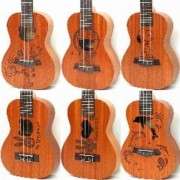Buffoons: the history of the phenomenon of buffoonery and its musical features.
Buffoons are healers and performers of ritual songs that remained after the Baptism of Rus’ by Vladimir. They wandered through cities and towns and sang ancient pagan songs, knew a lot about witchcraft, and were amusing actors. On occasion, they could heal the sick, they could give good advice, and they also entertained the people with songs, dances and jokes.
In the literary monuments of the 11th century, there is already a mention of buffoons as people who combined the qualities of such representatives of artistic activity as singers, musicians, actors, dancers, storytellers, acrobats, magicians, funny jokers and dramatic actors.
The buffoons used such folk instruments as paired pipes, tambourines and harps, wooden pipes and the Pan flute. But the main instrument of buffoons is the gusli, because they are depicted in various historical monuments in the context of musical and buffoon creativity, for example, on frescoes, in book miniatures, and also sung in epics.
Together with the gusli, an authentic instrument called the “beep” was often used, which consisted of a pear-shaped soundboard; the instrument had 3 strings, two of which were bourdon strings, and one played the melody. The buffoons also played nozzles – longitudinal whistle flutes. It is interesting that sniffles and harps in ancient Russian literature were often contrasted with a trumpet, which was used to gather warriors for battle.
In addition to the buffoons, next to the harp, the image of a gray-haired (often blind) old man was also mentioned, who sang epics and tales of past deeds, exploits, glory and the divine. It is known that there were such singers in Veliky Novgorod and Kyiv – Kyiv and Novgorod epics have reached us.
Parallel among European musical and sacred movements
Similar to the buffoons, there were musicians and singers in other countries – these were jugglers, rhapsodists, shpilmans, bards and many others.
The Celts had a social stratum – bards, these were singers of ancient legends and myths, people who knew secrets and were revered by others, as they were considered messengers of the gods. A bard is the first of three steps to becoming a druid, the highest level in the spiritual hierarchy. The intermediate link was the phyla, who were also singers (according to some sources), but took a great part in public life and in the development of the state.
The Scandinavians had skalds who had great power to burn the hearts of people with verbs and music, but music was not their main occupation, they cultivated the fields, fought and lived like ordinary people.
The fading tradition of buffoonery
The church actively persecuted buffoons, and their musical instruments were burned at the stake. For the church, they were outlaws, relics of the old faith that needed to be weeded out like weeds, so the buffoons were persecuted and physically destroyed by the Orthodox clergy.
After certain punitive measures, the pagan musicians were completely exterminated, but we still have songs that were passed down orally, we still have legends and images of amusing guslars. Who were they really? – We don’t know, but the main thing is that thanks to these singers we still have grains of sacred memory.



